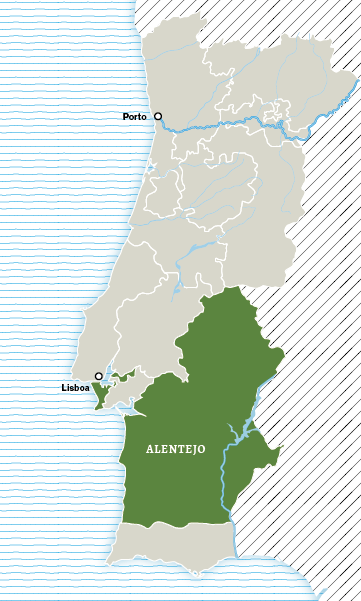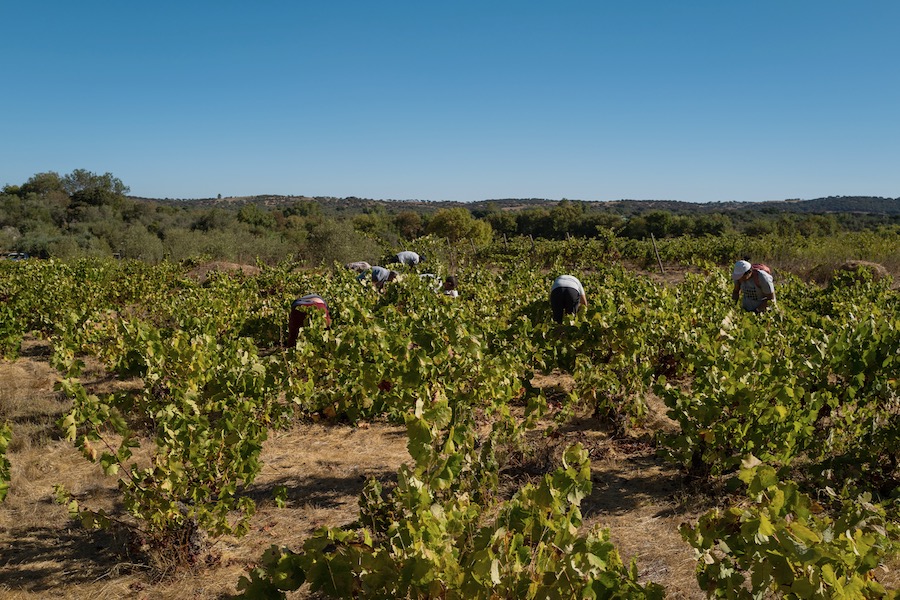Wine regions
Alentejo
In Lisboa, you have a choice between two bridges to cross the Tagus (Tejo) and enter the land 'beyond' (além) the Tagus, the Alen-tejo. In the rolling landscape, the cork oak occupies a prominent place, although olive trees and eucalyptus are gaining importance. These trees provide the main economic activity but, at the same time, the Alentejo accounts for a fifth of Portugal's total wine production.

That it is warm there is beyond doubt. Consequently, mostly sun-drenched wines are produced, which, in the meantime, often turn out a bit ripe for our taste. However, we find a few exceptions more than worthwhile. These are not accidentally produced in places where the temperature is milder.
Our Alentejo wines are characterised by a spicy to powerful style.
Location
This vast area is bordered to the north by the Tagus, which flows into the country from Spain just above the Serra de São Mamede to flow into the ocean just below Lisboa. The entire area below it, over a distance of 250km, is Alentejo. Although overall this is clearly the warmest region in Portugal, average temperatures still vary considerably from north to south. The area around the southern city of Beja almost achieves an average temperature of 25°C in July and August, with highs even daring to exceed 45°C.
In Portalegre in the north, those maxima rarely go above 40°C and summer averages are a full degree lower. For wine production, that makes a big difference.
Viniculture in Alentejo has a long history and with almost 25% of the total volume produced in Portugal, accounting for 1,170,000 hl, the region is clearly on the rise. Most of this (46%) is consumed in Portugal itself.
80% of production is red wine, which makes sense given the warm climate.
History
When exactly viticulture started in the region is not known, but it is certain that there were domesticated vines even before the arrival of the Phoenicians. Afterwards, the Greeks left a lot of traces with their small amphorae indicating growing viticultural activity,
but it was the Romans who made the main mark by introducing large terracotta amphorae (talhas de barro) in which the grape juice was fermented.
The arrival of the Moors almost completely wiped out viticulture, but the tradition of making wine in amphorae survived, while this custom was then lost in other Portuguese regions.
Wine production then went through periods of success and crisis over the centuries. After the phylloxera plague and the world wars of the 20th century, vineyards were mostly replaced by other crops before regaining importance from the 1980s onwards.
In 1988, the first DOC was approved and, as everywhere in southern Europe, many new projects were started with EU funds.
Today there are some 260 producers and about 100 merchants buying up grapes/wine, accounting for 20,000ha of which just over half are DOC area.
Red DOC wine must be wholly or at least 75% of a blend of the following grape varieties: Alfrocheiro, Alicante Bouschet, Aragonez, Cabernet Sauvignon, Castelão, Syrah, Touriga Nacional, Trincadeira.
In addition, about 25 other native and non-native varieties are allowed for a maximum of 25% of a blend.
White DOC wine must comprise all or at least 75% of a blend of: Antão Vaz, Arinto, Fernão Pires, Rabo-de-Ovelha, Roupeiro (Siria) and a few more little planted varieties.
Some 30 other varieties are also allowed in smaller percentages.
Jouw Dynamic Snippet wordt hier weergegeven ... Dit bericht wordt weergegeven omdat je niet zowel een filter als een sjabloon hebt opgegeven om te gebruiken.


